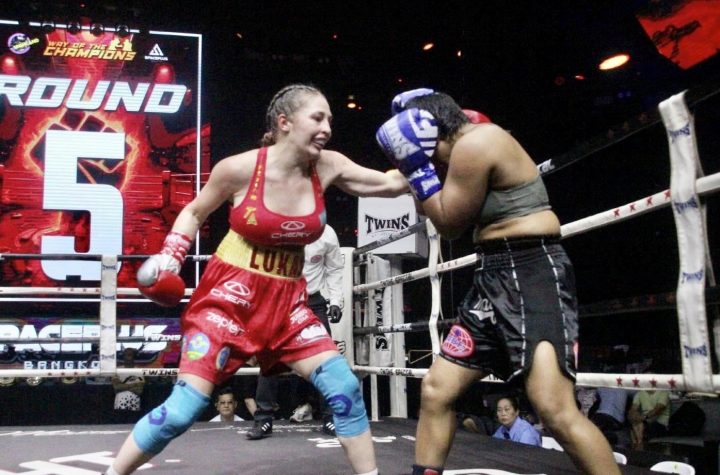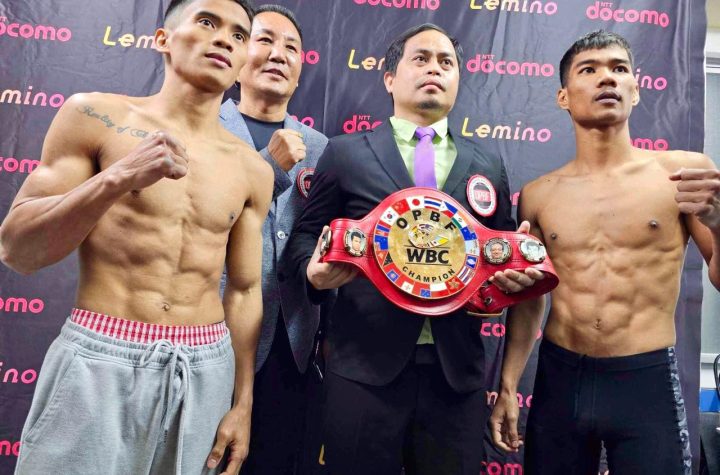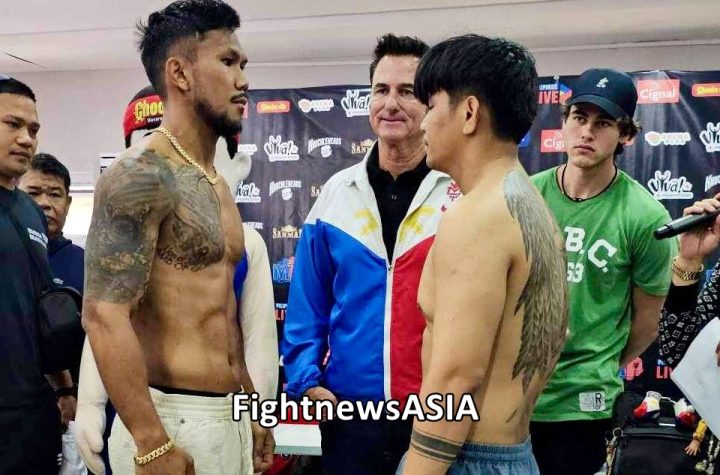

By Victor Lee
Photos: Mi-Kyung Lee
Fightnews.com
On Saturday night Korean boxing fans took to the streets of Seoul—only 35 miles from the North Korean border—with all manner of ghouls, goblins and zombies. Halloween festivities in full swing, Korean Boxing Management (KBM) held its second event in Itaewon, a bustling nightlife district popular with locals and foreigners alike, including United States soldiers (and MPs patrolling their stomping grounds) billeted at the nearby Yongsan military base. Like many of the professional cards held these days in Korea, the bouts took place at an educational institution: Itaewon Primary School. This felt both surreal and sensible, elementary schools being the sites where many experience their first fistfights.
With two title bout headliners, this special Halloween show featured an exciting line-up of four-on-four Korea vs. Japan matches. It also marked the first-ever WBC Eurasia title bout to take place in Korea. Initially scheduled for a double WBC Eurasia Korea-Japan showdown at light and super lightweight, a last-minute controversy resulted in a shift from the Eurasia to the KBM belt between the super lightweight contenders.
In the main event, baby-faced slugger Il-Kwon Kim (6-3, 30 KOs) met stylish technician Ryo Akahori—aka Juk-San Lee (7-3, 2 KOs)—for the vacant WBC Eurasia Interim Lightweight Title over ten rounds. Former WBO world featherweight title challenger (vs. Orlando Salido in 2011) Kenichi Yamaguchi, a member of Akahori’s team, provided a memorable a cappella rendition of the Japanese national anthem.
Riddled to pieces by the long jabs and straight shots of former contender Akihiro Matsumoto in a featherweight contest in Kanazawa, Japan in May 2013, Kim came back to win the Korean lightweight title by first round KO in April of this year. Akahori, a former amateur standout and capable counter puncher, came off a 3+ year layoff with a second round KO win in Osaka over Nattapol Sithsaithong on April 19, 2015, and logged his first victory on Korean soil against the underrated Sang-Bok Um this May.
Moving well behind his lead left and rapid combinations, Akahori began lambasting the crouched-over Kim, who persistently bored in under fire until a single straight right to the kisser cut Akahori down sideways, legs scissored on the canvas. Showing incredible samurai spirit, Akahori rose from unconsciousness and strode forward to continue at the referee’s instruction. Still a bit shaky, third man Kwan-Ho Jang wisely halted the bout at 1:52 of the first, crowing Kim WBC Eurasia titleholder via TKO.
Il-Kwon Kim—who appears to have found his ideal form at lightweight—rises to 7-3, 4 KOs. With three of his four KO wins coming in the first round, Il-Kwon (literally “One-Punch”) lived up to his name. Akahori drops to 7-4, 2 KOs, but remains undeterred, ready to continue pursuing his lifelong pugilistic goal of becoming a champion.
In the fight of the night—an all-out war and East Asia FOTY candidate—hot prospect and Korean super lightweight champion Woo-Min Won (8-1, 5 KOs), having seen his stock rise after an impressive third round demolition of perennial Japanese contender Daiki Koide in Nagoya, Japan in May, squared off against veteran power-puncher Taisho Ozawa (23-10-1, 14 KOs) for the newly established Boxing Management Super Lightweight title over ten.
Other reporters have noted erroneously that this bout marked Ozawa’s return after a 3+ year layoff. In fact, Ozawa has gone 2-2 over the past two years, most recently dispatching a Chinese opponent by first round knockout on July 9 on the undercard of a Jun Tao/Manny Pacquiao Promotion in Chengu, China (this match was officially logged online but inexplicably removed). Ozawa’s three other recent bouts are as follows: Feb 8, 2015, six round decision loss to Yuki Ishizumi; August 30, 2015, four round decision loss to Takumi Matsumiya; and April 23, 2016, six round decision win over Teppei Isomichi.
A little more history will help explain the electricity in the air before this bout: Ozawa, a veteran battler who made his pro debut in Tokyo in 1998, has crossed gloves with a number of top contenders. He stopped former Korean super lightweight champion Taek-Min Kim in one round in Tokyo in 2012, was stopped in five by former WBO regional titlist Rey Labao in 2013, and lost a split decision to current WBO Asia Pacific super lightweight champion Akihiro Kondo back in 2010.
Won vs. Ozawa: two hard punchers at a crossroads—who would win? An immediate pre-fight spike in betting interest between local gamblers indicated great interest among fight fans this Halloween night.
Ozawa made his first impression on the audience during the introductions when he directed decapitating motions at Won with an imaginary samurai sword. Resembling a pint-sized Leon Spinks, Ozawa continued to taunt Won with his crazed gap-toothed grin from ring center. Won, the pre-fight favorite, looked surprised when Ozawa backed up his gestures by landing the first stinging lead blows and counter hooks, deftly slipping—then mocking—Won’s powerful but ineffective lunges. Shocked again by Ozawa’s power and willingness to trade in round two, Won retreated after absorbing solid shots to the body and head. Confident in his own punching power, Won came back to land combinations, staggering Ozawa with his trademark left hook.
In round three Ozawa rebounded, lighting up Won with a stiff left jab. At distance the shorter, more experienced Ozawa clearly had the advantage, at times intercepting and confounding Won with a variety of hard left jabs and lead left hooks. One such ramrod jab stopped Won—about to throw a punch—dead in his tracks, a halo of sweat exploding from his hair upon impact. Despite his edge in skill, Ozawa—ever the gleeful warrior—was all-too eager to slug it out with Won, winging in shots toe-to-toe at every possible opportunity, his face plastered in expression of pure bliss. This proved detrimental in round four, when Won connected with a left-right-left hook combo that sent Ozawa crashing to the canvas. Taking the count on all fours, Ozawa rebooted, rose, and hurled himself back into the breach—this time more careful to cover up. Won, his confidence restored, laid on with a will, but Ozawa managed to survive, even sneaking in a few borderline body shots on the inside.
By round five behind his jab Ozawa was back in the saddle again, though a little worse for wear with a constant nosebleed, nicks on the outside corner of and below the right eye, and some serious swelling around it. Won’s right eye was also darkened and swollen from Ozawa’s lead blows and hooks. In the second half of the bout Ozawa, heeding the advice of his chief second, former Japan and OPBF champion Crazy Tiger Kim, dominated Won with the jab. Exhibiting superior defensive skills and ring generalship, Ozawa stung Won repeatedly from distance, expertly eluding most of his return blows. There was something about the effortlessness with which Ozawa took control in this manner that made one wonder what would have happened had he fought the entire bout with such poise and technical prowess. Won still looked to land the hook, but Ozawa shifted to a body attack, at times sapping Won with heavy uppercuts and hooks downstairs, occasionally raising the uppercut to the chin and forcing him back on the defensive.
In round nine, trying his best to make up for the round four knockdown, Ozawa came on strong, punishing Won to the body and head on the ropes and in the corner until he was warned for a low blow, and Won took his time to recuperate. For a moment near the end of the bout, Won was so frustrated by Ozawa’s jab and movement he huffed, lowered his hands, and stopped stone cold in the middle of the ring, utterly exasperated. The last round was a bit closer, and the crowd roared with approval until the final bell, when both fighters complimented and congratulated each other. While Won’s hand was soon raised in victory by scores of 96-94, 97-94, 98-93, many at ringside felt Ozawa—having gone ten rounds for the first time—had done enough to win with his jab alone (with which he appeared to sweep at least four of the last five rounds). Members of the Japanese team, however, accepting the powerful impression of Won’s salvos (especially the knockdown) on the local judges (all Korean), graciously admitted defeat. Won’s future opponents will likely study and aim to imitate Ozawa’s implementation of the jab, while Won would be well-advised to stop relying so much on the hook and work on his own jab. Back at the hotel, Ozawa—all smiles—expressed his love for the sport and made clear his desire to box on for the rest of his life—though preferably at lightweight.
Undercard:
The second Korea vs. Japan encounter pitted Korean welterweight champion Ma-Ru Jeong (4-3-1, 1 KO) against Daichi Yoshikawa (8-6, 6 KOs) in an eight-rounder, both boxers scaling in just south of a buck fifty. Although Boxrec followers will notice a nine year gap between Yoshikawa’s August KO victory in the Philippines and his previously listed bout, he in fact won by KO 3 against Keisuke Iwata on November 15, 2015 in Osaka, then dropped a decision to Takaya Shishimaru this April in Osaka. Probably the best 3-3-1 fighter in the world, Korean champion Ma-Ru Jeong wowed the audience with his chiseled physique.
The action here started off slowly, as both boxers—most likely never having seen any footage of each other—were wary from the outset, milling and circling, looking for openings and gathering knowledge on which to base and launch their attacks. After the referee warned both boxers for passivity, Jeong struck first. Jeong followed up with lighting fast combinations, while Yoshikawa fell just short with his blows. Coming in more aggressively, Jeong battered Yoshikawa, who attempted to cover up and swivel out of range. Just when it looked like a mismatch, Yoshikawa, playing possum in a crouch with his gloves held high, sizzled in a wicked right cross, causing a sickened expression to arise on Jeong’s face.
From that moment on, both boxer’s spirits ignited and the crowd came alive, cheering in appreciation as the two slugged it out toe-to-toe. In the third, Jeong backed Yoshikawa into the blue corner, bloodying his nose, and the two traded blows. Firing back furiously, Yoshikawa’s right arm got caught under the top rope. Luckily, he was able to extract it without injury and continue punching. In round four after another series of heated exchanges, the referee stopped the action and brought Yoshikawa to the corner to check his bloody nose. Upon inspection the ringside physician determined it was broken, and the referee—although Yoshikawa was game to continue—stopped the bout on the ring doctor’s advice at 0:53 of round four, registering Jeong’s first stoppage (TKO) win.
In the first of the four-on-four Korea vs. Japan matchups, up-and-coming Ju-Young Kim (5-1-3, 4 KOs), one half-pound over the welterweight limit, took on Takaya Shishimaru (6-5, 2 KOs), a fraction under the same limit, in a six round bout. Having lost a close decision for the Korean welterweight title to Ma-Ru Jeong in April, Kim rebounded with a fourth round TKO in July, while self-proclaimed showman Shishimaru’s most recent bout was an April 23, 2016 decision win over Daichi Yoshikawa in Osaka.
Decked out in pink and white with a pink afro wig, sun-glassed mask, plastic love-doll breasts and the lingerie equivalent of a tuxedo shirt, the Osakan visitor’s ring walk—or should we say “dance” (to the tune of “Gangnam Style”)—was one of the most memorable in Korean boxing history. Energized by his performance, the pink and white clad Japanese started out fast, landing speedy jabs and right uppercuts. After about one minute of the first stanza, however, it was all downhill for Shishimaru, who was flattened by Kim’s combinations in the first. Shishkabobbed by a right to the body and left to the head, Shishimaru went down again in the second and the referee waved off the fight, declaring Kim the victor by TKO at 2:48 of round two. Impressed by his performance, WBC Supervisor Alan Kim promised the winner a shot at the Eurasian title.
One thing that stood out most strikingly about all four Korea vs. Japan matches was the mutual respect and sportsmanship all eight boxers and their teams demonstrated toward each other. One imagines that if Korean and Japanese politicians behaved similarly, most of the tensions between these two nations would evaporate.
In the opening bout, a spirited but ugly super welterweight four-rounder, Gi-Won Shin (3-0) of Suwon edged out Hwang-Gil Kim (1-1) by scores of 39-38, 39-38, 40-38. It looked as though both boxers showed up in the same Halloween costume: that of the barroom brawler—as both threw (and mostly missed) haymaker after haymaker.
Venue: Itaewon Primary School, Seoul, South Korea
Promoter: Hannam Promotion, Hansang Kim




















More News
Marcial vs Sinam in Manila
Era, Lukas, Innes Win in Thailand
Vitor vs Kim in Bohol